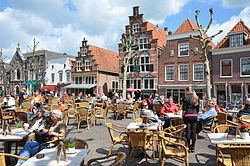Time zone CET (UTC+1) Website www.oudewater.nl Area code 0348 | Elevation 2 m (7 ft) Postcode 3420–3425 Area 40.1 km² Local time Tuesday 4:10 AM Team FC Oudewater | |
 | ||
Weather 5°C, Wind E at 3 km/h, 82% Humidity | ||
Oudewater ( [ˈʌudəˌʋaːtər]) is a municipality and a town in the Netherlands.
Contents
Map of Oudewater, Netherlands
History
The origin of the town of Oudewater is obscure and no information has been found concerning the first settlement of citizens. It is also difficult to recover the name of Oudewater. One explanation is that the name is a corruption of old water-meadow. Oudewater was an important border city between Holland and Utrecht. Oudewater (lit. "Old water") was of great strategic importance.
The town was granted city rights in 1265 by Hendrik van Vianden, the bishop of Utrecht.
Oudewater took place in the First Free States council in Dordrecht on 19 July 1572, Oudewater was one of the twelve cities taking part in the first free convention of the States General in Dordrecht. This was a meeting that laid down the origin of the State of the Netherlands, as we know it now, under the leadership of the House of Orange. This happened at the beginning of the Eighty Years' War (1568–1648) when the Netherlands were still part of the Spanish Empire. After a Siege of Oudewater, the city was conquered by the Spanish on 7 August 1575, and most of its inhabitants were killed, including the family of famous Oudewater native and Protestant theologian Jacobus Arminius (1560-1609).
In the 16th and 17th century, Oudewater was an important producer of rope. In the surrounding area, hemp was cultivated. There still is a rope manufacturing plant and a rope museum in the town.
Oudewater is the setting for the 1975 novel Das Geheimnis des Baron Oudewater set in the 16th century, when the Netherlands was fighting for its independence from Spain. Written by the German author Alberta Rommel, it has been described as a romantic historical novel.
Geography
Oudewater is located at 52°1′N 4°52′E in the southwest of the province of Utrecht in the center of the Netherlands. It is situated where the Linschoten river flows out in the Hollandse IJssel.
Oudewater is bordered by the municipalities of Montfoort (in the northeast), Lopik (southeast), Krimpenerwaard (southwest), and Bodegraven-Reeuwijk (northwest).
The municipality of Oudewater consists of the following cities, towns, villages and/or districts: Hekendorp, Oudewater, Papekop, Snelrewaard.
Buildings
Oudewater is famous for the Heksenwaag (Witches' scales). This Weighing house, an official town building, became famous during the 16th century because people accused of witchcraft were offered an honest chance of proving their innocence. In many cities and countries such trials were usually rigged, resulting in the burning or drowning of hundreds of innocent people.
Many people accused of witchcraft from all over Europe (or at least, those who could afford the trip) made a head-over-heels trip to Oudewater to avoid being burned at a stake. After the weighing, they received an official certificate proclaiming them not a witch. Although nobody was ever found to be an actual witch in Oudewater, the weighings were still a public spectacle. Even today you can get a certificate that "your body weight is in proportion to your build." The reasoning behind this is the old belief that a witch has no soul and therefore weighs significantly less than an ordinary person; this distinction allows the witch to fly on a broomstick.
So in medieval times when accusations of witchcraft (and resultant burnings) were prevalent, the town of Oudewater offered the accused a chance of proving his or her innocence. This was more special than it sounds. It is a sign of the growing power of a third force next to church and nobility, i.e. citizens. In a bid for total domination, the witchhunts were sanctioned by the church to break the power of the local herb doctors (especially the females). The citizens of Oudewater therefore were, simply by being honest, defying the church.
The Waag is still open as a tourist attraction, and official certificates are available.
The town hall dates from 1588 and features a stork's nest. Oudewater has a monumental protected city centre with more than 250 protected houses. The church, now Protestant, dates from the 15th century. Its tower is from about 1300. During the religious wars, until the sacking of Oudewater, both Roman Catholics and Protestants used this church. Thereafter Catholics were still tolerated (the Spanish occupators being Catholic) but more in low profile.
